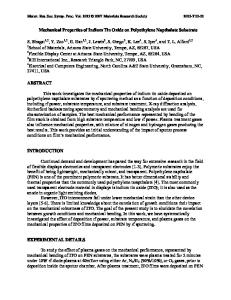Effect of Inactivated Dopants Clusters and Processing Parameters on Electrical Properties of Indium Tin Oxide on Plastic
- PDF / 380,006 Bytes
- 6 Pages / 612 x 792 pts (letter) Page_size
- 23 Downloads / 342 Views
1074-I05-16
Effect of Inactivated Dopants Clusters and Processing Parameters on Electrical Properties of Indium Tin Oxide on Plastic Substrates Hauk Han1, Jay Lewis2, and Terry Alford1 1
School of Materials and Flexible Display Center at ASU, Arizona State University, Tempe, AZ, 85287 2
Center for Materials and Electronic Technologies, RTI International, Research Triangle Park, NC, 27709 ABSTRACT Indium tin oxide (ITO) thin films were deposited on polyethylene napthalate (PEN) by rf sputtering using different rf powers (60 and 120 W) and at different substrate temperatures (room temperature and 100 °C). Rutherford backscattering spectrometry was used to determine the oxygen content in the films. Hall effect measurements were used to evaluate the electrical properties. In this paper the influence of defect structure, sputtering conditions, and the effect of annealing on the electrical and optical properties of ITO on PEN have been investigated. Electrical properties such as carrier concentration, mobility, and resistivity of the ITO films varied with rf power and substrate temperature. The electrical properties of the films changed after annealing in air. This study also describes how the as-deposited amorphous ITO changes from amorphous to crystalline as a result of heat treatment, and investigates the effects of Sn defect clustering on electrical and optical properties of the ITO films. INTRODUCTION Indium tin oxide (ITO) films are widely used for optoelectronic devices on glass substrates and have been introduced as transparent electrodes on polymer substrates due to their high electrical conductivity coupled with high transmission in the visible range [1]. There is much interest (in optoelectronic and photovoltaic industries) in the development of microelectronic devices on flexible substrates. Ideal materials for flexible substrate include polymers, metal foils, and thin glass substrates. Transparent conducting oxides (TCO) such as ITO are of particular interest for use as transparent electrode materials on flexible substrates. Early studies of ITO on polyethylene napthalate (PEN) substrates have shown that electrical transport and optical properties of ITO films are strongly dependent on oxygen content, defects, impurity states, and substrate surface morphology [2]. These results correlate with growth conditions such as oxygen partial pressure, substrate temperature (TS), bias voltage, and
deposition method. In this work we investigate the influence of varying rf power and substrate temperature on the electrical and optical properties of ITO thin films on PEN. EXPERIMENTAL DETAILS Selected PEN polymer substrates (Dupont Teijin Films, Teonex® Q65) were plasma treated with Ar. Thin films of ITO were then deposited onto PEN substrates using rf sputtering. Sputtering was conducted in an Ar–O2 atmosphere using different rf powers of 60 and 120 W. Substrate temperatures were room temperature and 100 °C. Sample descriptions are listed in Table 1. Table I. Sample descriptions TS
rf power
Thickness (nm)
S1
RT
Data Loading...










